Following your consultation with the clinician, you have been diagnosed as having mechanical back pain. You may have strained your back doing something specific eg bending or it may have come on out of the blue for no obvious reason. The good news is that back pain is rarely due to anything serious and does get better on its own quite quickly, mostly within six weeks.
There is good evidence that keeping active speeds up recovery from back pain. Bed rest for more than 1-2 days is definitely not beneficial and no longer recommended. Stress can increase the amount of pain you feel. Tension can cause muscle spasm so try to relax at least once a day and try some simple relaxed breathing.
During your recovery period you will have good days and bad days, remember that is perfectly normal. Do not be frightened by the pain, hurt does not mean you are harming your spine. The information below is designed to help you help yourself to a speedy recovery.
Pain Killers
Use anti-inflammatory medication and analgesics as directed by your clinician in the early stages. Anti-inflammatories need to be taken regularly as prescribed for best effect, not just when it is painful. Good pain relief helps you to keep mobile and keeping mobile speeds up recovery.
Posture
Try to change activities and position frequently. Do not sit, lie, or walk for too long and do not stay in one position for more than 20-30 minutes. Don’t worry if you cannot sit comfortably at all, or for only 5-10 minutes. This is quite normal and will improve.
Sitting
Sit on a chair with a supportive back and firm seat. Ensure your hips are at the same level as your knees. Put a rolled towel into the small of your back and sit back against it to keep you upright. Avoid crossing your legs. Avoid long sitting with your legs out straight as this causes you to round your back eg sitting with legs up on a stool or sitting up in bed.
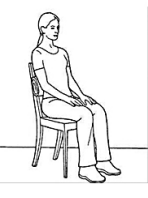
Stand to sit / sit to stand
If you have a lot of pain standing from sitting, try to slowly lower yourself down using your thigh muscles, keeping your back neutral. Ease back into the seat. If the chair has arms, use them to help you.
For sit to stand, reverse the process for standing up – again use the chair arms to help you push up.
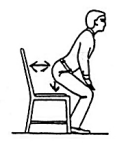
Active Rest
It is alright to rest for short periods during the day, eg 20-30 mins at a time. These are examples of positions that maybe comfortable and help with relaxation. It is important to use rest as part of your rehabilitation but do not rest for long periods at a time as this will lead to stiffness and weakness of your back muscles.

Consider using ice or heat on the painful areas whilst you are in the resting positions (see
section Heat/Ice for details).
Standing/walking
Maintain good posture to avoid straining painful muscles. Try to avoid using a walking stick as this leads to poor posture and body movement which can prolong your pain. Try not to hold yourself stiffly as you move as this can cause more pain due to tense muscles. When in acute pain, try to walk around your house. As the pain reduces, try to walk outside within your limits of pain. Increase the distance as the pain reduces. As you improve consider swimming to increase your activity further.
Heat/Ice
If your pain has come on following an injury, use ice for the first week, either crushed ice cubes wrapped in a damp towel, or a pack of frozen peas wrapped in a damp tea towel for ten minutes. After one week, try heat, ie hot water bottle wrapped in a towel and then choose whichever is most beneficial for you. It may only give short term relief, but if you reapply regularly to the back (10 minutes for cold pack and 15-20 minutes for heat pack) it helps to relax the muscles and aid the natural healing process. Please check that you can feel the difference between hot and cold on your skin before you apply the heat or cold pack.
Sleep
People with back pain usually prefer a firm mattress and one pillow. Avoid sleeping in a chair or on the floor.
Activities
Remain as normally active as pain allows, checking that your posture is good. Taking rest periods before the pain gets worse is also helpful.
Lifting
Avoid lifting anything too heavy, if not, remember to keep the load close to you and, use your knees to lift not your back. Have one foot close/alongside the load and the other foot behind, face the direction you will be moving in. Don’t twist your back or use your feet to turn.

Work
You may need a few days off but unless you have a heavy manual job, the sooner you get back to work, the better, even if you still have some pain and restrictions. If you are having problems with the following activities of daily living, try these tips to help your back.
Dressing
Sit to dress/undress the lower half of your body. This avoids straining the body to maintain balance.
Getting out of bed
If it is difficult to get out of bed try to roll onto your side, take your legs over the side of the bed and push up sideways lowering your feet to the floor.

Getting into bed
Reverse of above.

Driving
It is better to be a passenger than to drive if your pain is very acute in the early stages. If you do drive, have the seat as close to the pedals as possible to avoid stretching your legs out, and alter the angle of the seat back to more of an upright position to avoid stretching your arms out for the steering wheel. Use a roll or wedge if necessary in the small of your back to maintain good posture. Also please liaise with your insurance company regarding any restrictions you might have due to your back pain.
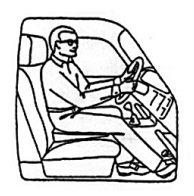
Activities of daily living
Take showers rather than sitting in a bath as not only will sitting with your legs out straight be painful but getting in and out of the bath will be difficult too.
Limit any bending and twisting while the pain is acute. Do not try to pick up children. Instead, sit down and get them to come to you.
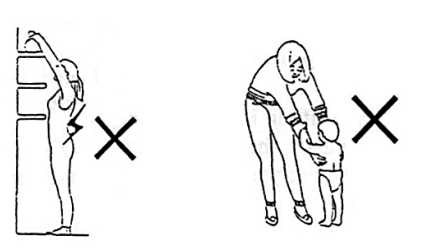
Kneel to reach down
Bend your knees to get yourself down to the level of the basin to reduce the need to bend your back to wash face, clean teeth, shave etc. Do not wash hair over the sink or side of a bath, use the shower.
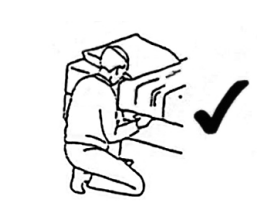
Sink activities
Upturn a bowl in the sink and put usual bowl on top. This reduces the amount you need to bend forward by lifting the level of the bowl.
Exercises
Lying on your back with your knees bent up and arms by your side.
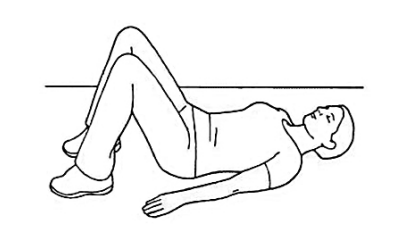
- Gently rock your knees side to side within your pain free range. Repeat up to 10 times.
- Tighten your stomach muscles and gently press the small of your back against the floor. Then slowly rock your pelvis forward and lift your back away from the floor, again within your pain free range. Repeat x10 if possible.
- Keeping your back in this neutral start position gently pull in your lower stomach muscles and hold for 10 seconds. Repeat x 10 if possible.
Remember: Most back pain does get better. It just takes a little time. The more you put the advice into practice, the better recovery you should make.
NB. If you feel the exercises are making your pain worse stop doing them and ask for advice.
If you are having any concerns about your injury, you can seek further advice from your own GP, return to the Minor Injury Unit or attend the Accident and Emergency Unit
Please contact your GP or NHS111 for any queries or concerns.